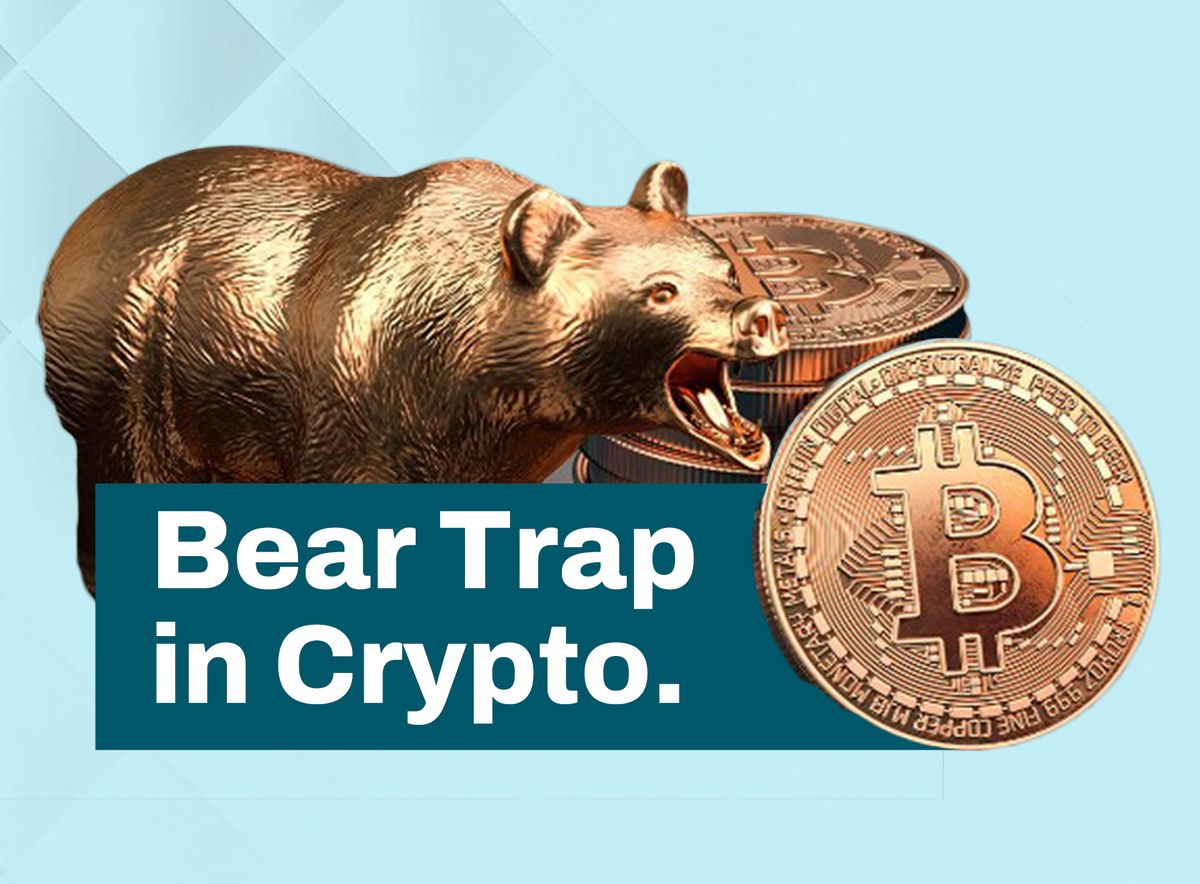What is a Bear Trap in Crypto and How Do You Avoid It?
A bear trap tricks traders into selling before a price rebound. Learn how bear traps work and how to spot them to protect your crypto.

TABLE OF CONTENTS:
1. What is a Bear Trap in Crypto
2. How Does a Bear Trap Work
3. What Causes Bear Traps?
4. How to Avoid Falling into a Bear Trap
5. FAQs
6. Closing Thoughts
One such trap that frequently entangles newcomers and experienced traders alike is the notorious "Bear Trap."
So, what exactly are bear traps in crypto, and how can you avoid them?
What is a Bear Trap in Crypto?
Imagine you're hiking through a forest, and suddenly you stumble upon a hidden trap carefully camouflaged with leaves and branches. In crypto, a bear trap is much like this.
It's a deceptive market situation that tricks investors into thinking that the price of a particular cryptocurrency is going to keep falling, prompting them to sell their assets at a loss or refrain from buying.
However, it turns out to be a temporary price drop, and once traders have been scared away, the market bounces back, leaving them regretting their hasty decisions.
How Does a Bear Trap Work?
Let's say you've been following the price of CryptoX, and it's been on a steady decline for a while. Fear sets in, and you decide to sell your CryptoX tokens, thinking it's the safest choice to prevent further losses.
But then, out of the blue, a piece of positive news regarding CryptoX's adoption or a major market event creates a sudden surge in demand.
The price of CryptoX shoots up, and you're left on the sidelines, watching others profit while you're nursing your losses.
According to historical data, many bear traps have played out over the years, affecting various cryptocurrencies.
For instance, in 2017, Bitcoin faced a severe bear trap when its price dropped from nearly $20,000 to around $6,000, causing widespread panic among investors.
However, by the end of 2017 and early 2018, Bitcoin's price soared back to new heights, reaching almost $20,000 again. Those who sold in fear during the drop missed out on the opportunity to capitalise on this rebound.
What Causes Bear Traps?
1. Market Sentiment Shifts: Bear traps often spring from sudden shifts in market sentiment. When negative news or rumours start circulating about a particular cryptocurrency, it can cause a panic sell-off. This can quickly turn a bullish market into a bearish one.
2. Whale Manipulation: Large investors, often referred to as "whales," can influence the market significantly. When a whale decides to dump a substantial amount of cryptocurrency, it can trigger a bearish trend, leading smaller investors to follow suit.
3. Regulatory Developments: Regulatory changes and crackdowns by governments can be a major cause of bear traps. When a government announces strict regulations or bans on crypto, it can lead to widespread panic selling.
4. Overleveraging: Many traders use leverage to magnify their gains, but it can also lead to significant losses. Overleveraging occurs when traders borrow more than they can afford to lose. When the market turns against them, it can trigger a bear trap.
5. Lack of Fundamental Support: If a cryptocurrency lacks strong fundamentals, it can be vulnerable to bear traps. A lack of real-world use cases, a weak development team, or a lack of partnerships can all contribute to a sudden drop in value.
6. Market Cycles: Cryptocurrency markets are known for their periodic nature. Bear traps often occur when a bullish trend has been going on for an extended period, and investors start to believe it's a new norm. This over-optimism can set the stage for a sharp correction.
7. Market Manipulation: pump and dump schemes are not uncommon in the crypto world. Dishonest individuals or groups artificially inflate the price of a cryptocurrency to attract investors before selling off at a profit. When the scheme is exposed, it can trigger a bear trap.
How to Avoid Falling into a Bear Trap
Now that we understand what a bear trap is, let's explore how to avoid it:
1. Stay Informed: The key to avoiding a bear trap is staying informed about the crypto market. Follow reputable news sources and keep an eye on the overall market sentiment.
2. Use Technical Analysis: Technical analysis involves studying price charts and indicators to make informed trading decisions. It can help you identify potential bear traps by recognising patterns and trends.
3. Set Stop-Loss Orders Wisely: While stop-loss orders can protect you from significant losses, set them at a reasonable distance from the current price. Placing them too close can make you vulnerable to bear traps.
4. Diversify Your Portfolio: Don't put all your eggs in one basket. Diversifying your investments across different cryptocurrencies can reduce the impact of a bear trap on your overall portfolio.
5. Avoid Emotional Trading: Emotional decisions often lead to falling into bear traps. Stick to your trading strategy, and don't let fear or greed dictate your actions.
6. Stay Cautious of Quick Fixes: Be wary of sudden price spikes and take the time to analyse the situation. Quick fixes can sometimes be traps in disguise.
7. Consider Long-Term Holding: If you believe in the long-term potential of a cryptocurrency, consider holding it for the long haul rather than trying to time the market.
8. Follow Trading Community Discussions: Online forums and social media can provide valuable insights into market sentiment. Engage with the crypto community to gain different perspectives.
9. Utilise Risk Management Tools: Some trading platforms offer risk management tools like trailing stop orders. These can help you secure profits while also limiting potential losses.
10. Learn from Experience: If you do fall into a bear trap, view it as a learning experience. Analyse what went wrong and use it to refine your trading strategy.
FAQs
Q1. Can a bear trap last for an extended period?
A1. A bear trap is typically short-lived, lasting from a few hours to a few days. It's designed to deceive traders in the short term.
Q2. Is a bear trap the same as a market correction?
A2. No, a bear trap is a temporary manipulation of prices, while a market correction is a natural and healthy part of the market cycle.
Q3. Are there specific cryptocurrencies that are more prone to bear traps?
A3: Bear traps can potentially happen with any cryptocurrency, as they are driven by market sentiment and manipulation rather than the coin itself.
Q4. What's the difference between a bear trap and a bull trap?
A4: A bear trap tricks traders into thinking the price will go down, while a bull trap lures traders into thinking the price will go up.
Q5. Are there any warning signs that a bear trap is about to happen?
A5. Some signs include unusually high trading volume during a downward trend and rapid price drops followed by quick recoveries.
Q6. Can bear traps be avoided entirely?
A6: While they can't be completely avoided, being cautious and informed can significantly reduce the risk of falling into a bear trap.
Q7. Is it better to hold or sell during a potential bear trap?
A7. The decision depends on your trading strategy and market analysis. It's essential to make an informed choice based on your goals.
Q8. Are there bear traps in traditional financial markets as well?
A8. Yes, bear traps can occur in traditional markets, but they are more common in highly unstable markets like cryptocurrencies.
Q9. How can I distinguish a bear trap from a genuine price decline?
A9. Distinguishing between the two can be challenging. It often requires a combination of technical analysis and market sentiment assessment.
Q10. What should I do if I suspect I've fallen into a bear trap?
A10. If you suspect you've fallen into a bear trap, stay calm, reassess your trading strategy, and consider consulting with experienced traders or financial advisors for guidance.
Closing Thoughts
To avoid falling into a bear trap, it's crucial to conduct thorough research, stay updated with the latest news, and not let short-term price fluctuations dictate your decisions.
Distinguishing between a genuine bearish trend and a temporary market dip is a skill that can save you from unnecessary losses in the volatile world of cryptocurrency.
Bear traps are part and parcel of the crypto landscape, but with knowledge, patience, and a steady hand, you can navigate through them and make informed investment choices.
Disclaimer: This article was written to provide guidance and understanding. It is not an exhaustive article and should not be taken as financial advice. Obiex will not be held liable for your investment decisions.




